CMS at the University of Colorado
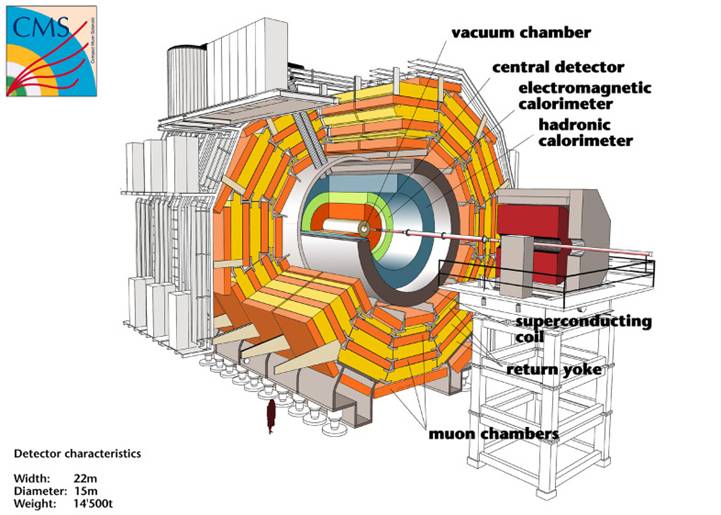
Several members of the High Energy Physics (HEP) group at the University of Colorado at Boulder (CU) are working on the CMS experiment. CMS (Compact Muon Solenoid) is an experiment which is running at the Large Hadron Collider (LHC) at CERN in Geneva, Switzerland. The main goals of the CMS Collaboration are to discover (or rule out at some level) the existence of the Higgs particle and supersymmetry as well as look for other new physics at the energy frontier. The experiment began taking data in 2009.
The CU HEP group is currently working on detector development, track reconstruction improvements, and a variety of physics topics including searches for supersymmetry, searches for high mass gauge bosons, and measurements of b-hadron production and decays.
The CU HEP members involved in CMS are:
- Professor John Cumalat
- Professor William Ford
- Research Professor James Smith
- Assistant Professor Kevin Stenson
- Associate Research Professor Stephen Wagner
- Emeritus Professor Uriel Nauenberg
- Research Associate Alessandro Gaz
- Research Associate Eduardo Luiggi
- Research Associate Keith Ulmer
- Graduate Student Brian Drell
- Graduate Student Troy Mulholland
- Graduate Student Andrew Johnson
Current projects
Searches for Supersymmetry
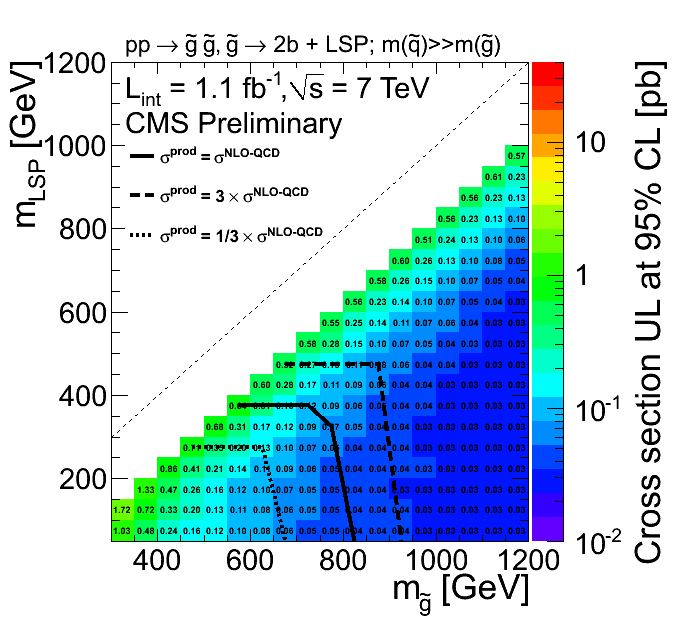 Ford, Smith, Gaz, Mulholland and Ulmer are searching for decays of supersymmetric
particles in final states with bottom-quark jets. Supersymmetry is an attractive extension
of the Standard Model, which may help explain the hierarchy problem and provides a natural
candidate for dark matter. Final states with bottom-quark jets are particularly appealing
for scenarios with relatively light third generation scalar quarks, which help preserve
the naturalness of the broken symmetry.
Results from this analysis
are available.
As no signal is observed, upper limits are placed on the maximum possible cross section for
the production of the supersymmetric particles as a function of gluino and LSP mass as shown
in the plot at right.
Ford, Smith, Gaz, Mulholland and Ulmer are searching for decays of supersymmetric
particles in final states with bottom-quark jets. Supersymmetry is an attractive extension
of the Standard Model, which may help explain the hierarchy problem and provides a natural
candidate for dark matter. Final states with bottom-quark jets are particularly appealing
for scenarios with relatively light third generation scalar quarks, which help preserve
the naturalness of the broken symmetry.
Results from this analysis
are available.
As no signal is observed, upper limits are placed on the maximum possible cross section for
the production of the supersymmetric particles as a function of gluino and LSP mass as shown
in the plot at right.
Searches for additional gauge bosons
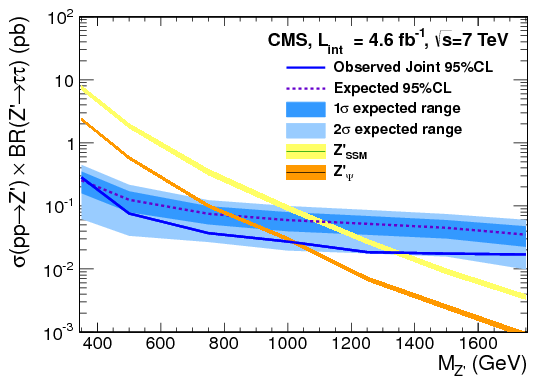 Cumalat and Luiggi are searching for a Z' decaying to two tau particles. The Z' would be
a heavier version of the Z0 and is a common feature in many theories beyond the Standard
Model. If lepton flavor universality holds, a Z' discovery would occur in the electron or
muon channels. However, many theories predict enhanced 3rd generation couplings, in which
case the ditau decay could be the discovery mode and the gateway to new physics. So far,
no Z'→τ+τ− signal has been observed, leading to
the limits shown on the right.
Cumalat and Luiggi are searching for a Z' decaying to two tau particles. The Z' would be
a heavier version of the Z0 and is a common feature in many theories beyond the Standard
Model. If lepton flavor universality holds, a Z' discovery would occur in the electron or
muon channels. However, many theories predict enhanced 3rd generation couplings, in which
case the ditau decay could be the discovery mode and the gateway to new physics. So far,
no Z'→τ+τ− signal has been observed, leading to
the limits shown on the right.
Studies of b-hadron production and decay
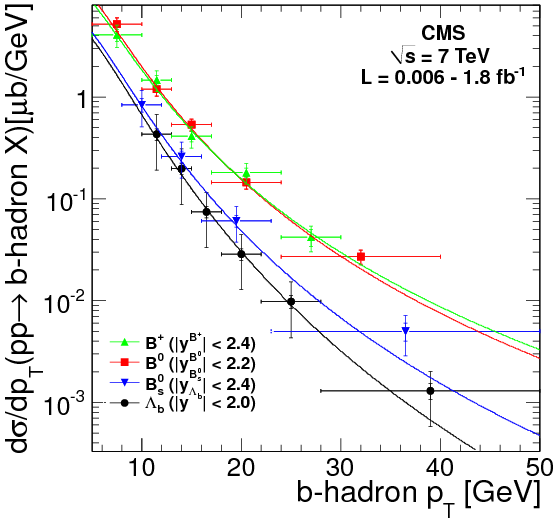 Stenson is leading an effort to study the production and decay of b-hadrons (particles containing
a b quark). Utilizing the new energy available at the LHC, Ulmer has produced measurements of the
production of B0 mesons
and Λb baryons
as a function of the longitudinal variable, rapidity, and the transverse variable, transverse momentum. The
plot on the right shows the pT distribution for four b-hadrons. It is seen that the Λb
falls more rapidly than the mesons.
Stenson is leading an effort to study the production and decay of b-hadrons (particles containing
a b quark). Utilizing the new energy available at the LHC, Ulmer has produced measurements of the
production of B0 mesons
and Λb baryons
as a function of the longitudinal variable, rapidity, and the transverse variable, transverse momentum. The
plot on the right shows the pT distribution for four b-hadrons. It is seen that the Λb
falls more rapidly than the mesons.
Drell is currently working on an analysis to measure the polarization of the Λb baryons in CMS. This involves a simultaneous fit to five angular distributions with seven free parameters. Former post-doc Mauro Dinardo is continuing work with Colorado in a study of the decay B0→K*0μ+μ−. As this decay is heavily suppressed in the Standard Model, it is sensitive to effects of new physics which may appear in particular aspects of the decay. In the future Stenson plans to measure properties of the Λb→Λμ+μ− decay which also may reveal the presence of physics beyond the Standard Model.
Diamond detector development
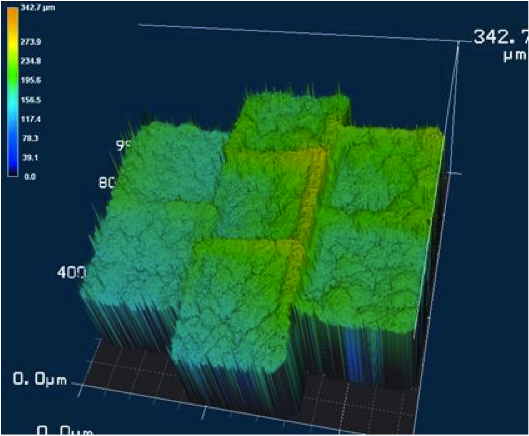 Wagner is leading the CU effort (with Cumalat and others) to develop tracking detectors
using diamond, grown using chemical vapor depsosition (CVS), instead of silicon as the
sensitive material. The main advantage of diamond over silicon is that it is
intrinsically radiation hard. Therefore, it is a natural choice for the innermost layer
of a tracking detector, especially for an upgraded LHC operating at much higher
luminosity. Diamond also has very high thermal conductivity making cooling easier and low
noise. The electron and hole mobility is also very high so the diamond signals are very
fast. There are downsides to diamond as well. The higher bandgap results in less signal
than silicon and the presence of impurities (or graphite) can trap charge. Most
importantly, the manufacturing of diamond is a niche field rather than the basis of all
modern technology like silicon. Colorado is working on ways to improve the capabilities
of diamond to make it viable for a tracking detector. Most diamond is grown as polycrystalline
diamond where the growth surface is silicon which has a very different lattice spacing than
diamond. Single crystal diamond has better properties but can only be grown on a diamond
surface. Since large diamond surfaces are not possible, Colorado is working on developing
mosaic technology where several small diamond surfaces are placed together to grow a single
large diamond. The plot at right shows the result of one attempt with 7 diamonds.
Wagner is leading the CU effort (with Cumalat and others) to develop tracking detectors
using diamond, grown using chemical vapor depsosition (CVS), instead of silicon as the
sensitive material. The main advantage of diamond over silicon is that it is
intrinsically radiation hard. Therefore, it is a natural choice for the innermost layer
of a tracking detector, especially for an upgraded LHC operating at much higher
luminosity. Diamond also has very high thermal conductivity making cooling easier and low
noise. The electron and hole mobility is also very high so the diamond signals are very
fast. There are downsides to diamond as well. The higher bandgap results in less signal
than silicon and the presence of impurities (or graphite) can trap charge. Most
importantly, the manufacturing of diamond is a niche field rather than the basis of all
modern technology like silicon. Colorado is working on ways to improve the capabilities
of diamond to make it viable for a tracking detector. Most diamond is grown as polycrystalline
diamond where the growth surface is silicon which has a very different lattice spacing than
diamond. Single crystal diamond has better properties but can only be grown on a diamond
surface. Since large diamond surfaces are not possible, Colorado is working on developing
mosaic technology where several small diamond surfaces are placed together to grow a single
large diamond. The plot at right shows the result of one attempt with 7 diamonds.
Tracking development
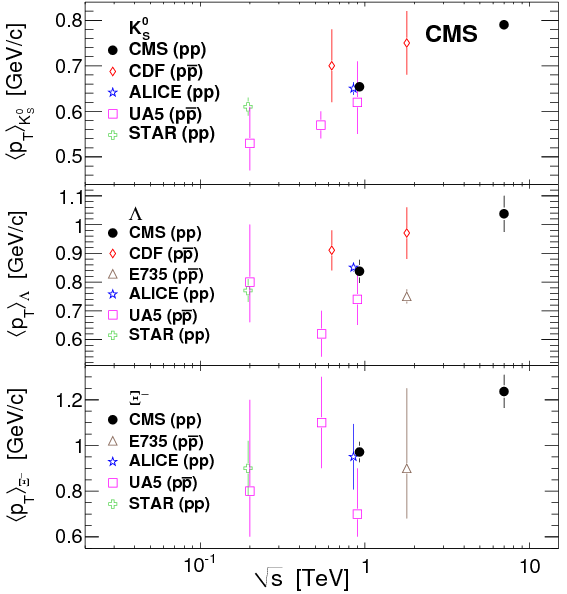
Stenson is the co-convener of the CMS Tracking Physics Object Group which is responsible for track reconstruction. During the past year, Stenson has been working on reducing the CPU time taken by track reconstruction. This was a critical issue due to pileup, multiple collisions taking place at once. As the pileup increases (to ~30 in 2012), the number of hits increases linearly but the possible combinations increases much faster, resulting in code which ran too slow to use. After 9 months of work, the track reconstruction runs 5 times faster with no loss in physics performance.
Stenson has also made significant improvements in the reconstruction efficiency, especially for tracks which originate away from the collision region (displaced tracks). Some of these tracks come from the decays of long-lived strange particles such as K0 or Λ (generically known as V0). Drell developed a module in CMS to reconstruct these particles. Stenson, Drell, Luiggi, and Ulmer published a physics analysis of strange hadron production. These results are used to better understand the physics at high energy and to tune models of particle production which are used in particle physics to understand the data.
Past projects
Forward Pixel Project
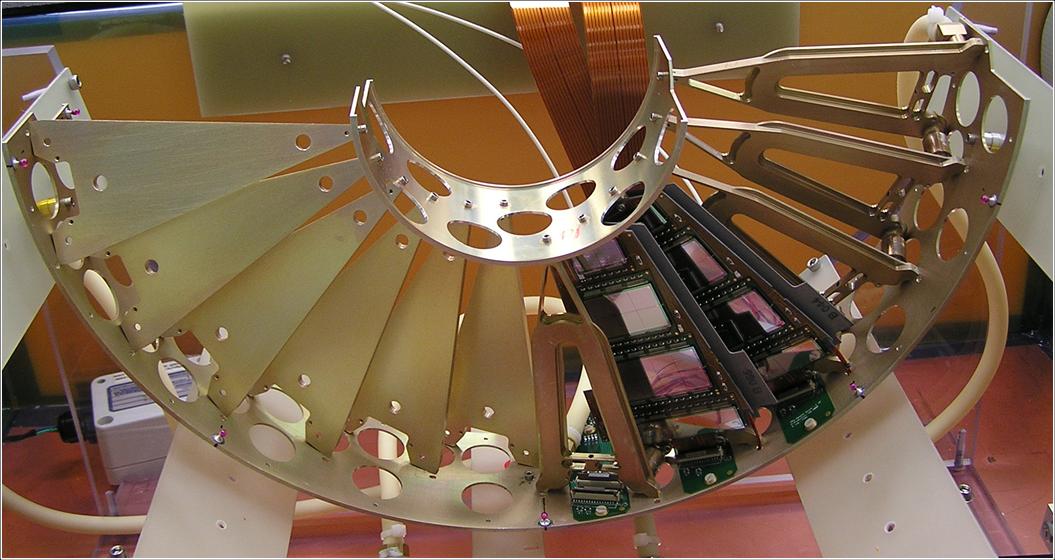
The Colorado group was responsible for the commissioning of the forward pixel detector at CERN. This activity was led by post-doc Mauro Dinardo with assistance from Cumalat and Stenson and lasted from January 2007 until installation of the detector in 2008. During 2007 he prepared the clean room for the reconstruction and testing of the forward pixel system by setting up the needed power, electronics, chiller, dry air, and testing systems. He has also made successful tests of the forward pixel detectors using charge injection and radioactive sources. Shown at right is the preproduction forward pixel detector which was used to debug the commissioning procedures and for a variety of tests including tests of radiation damage.